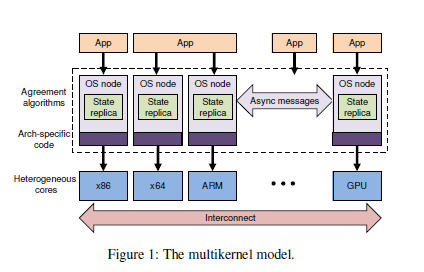Microsoft and European researchers deliver a snapshot of multikernel 'Barrelfish' OS

Microsoft and European researchers have released a "snapshot" of Barrelfish, which is a "multikernel" distributed operating system project in which Microsoft's Cambridge (UK) Research Lab has a big part.

(The licensing/copyright terms for Barrelfish are here, along with a note that the Os includes "some third-party libraries, which are covered by various BSD-like open source licenses.") The team also noted that "a more complete (and usable) release" of Barrelfish will be coming "soon."
According to the Microsoft Research Web site, Barrelfish is one of a number of projects in which Microsoft is involved in the multi/many-core space. Here's the description of the project:
"We are exploring how to structure an OS for future multi- and many-core systems. The motivation is two closely related hardware trends: first, the rapidly growing number of cores, which leads to scalability challenges, and second, the increasing diversity in computer hardware, requiring the OS to manage and exploit heterogeneous hardware resources."
Microsoft and the ETH Zurich researchers have made available several white papers outlining the goals and design of Barrelfish. None of those papers mention "Midori," another distributed operating-system project that is in incubation at Microsoft, nor Singularity, another Microsoft Research operating-system project that inspired Midori.
But there still are a few interesting tidbits in the Barrelfish papers. The Barrelfish project may have implications for Microsoft's Dryad and Google's MapReduce, two programming initiatives that are key to the two companies' datacenter/cloud efforts. (Here's what I've written on Microsoft's Dryad concurrent-computing work, if you want more background.)
From Microsoft's latest Barrelfish paper:
"Structuring the OS as a distributed system more closely matches the structure of some increasingly popular programming models for datacenter applications, such as MapReduce and Dryad, where applications are written for aggregates of machines."
And ARM processors are on the list of those slated to supported by Barrelfish. Microsoft's Windows Embedded CE operating system runs on ARM but no variants of Windows do (at least for now).
Any OS experts out there see anything else of note in the Barrelfish papers? Any thoughts as to how it might fit (or not) with what we've heard to date about Microsoft Midori?